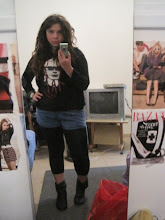A Blessing
The Shemonah Esrai (Eighteen Prayers) or Amidah is a daily prayer mandatory for all Jews to be spoken each day. It is one of the most important prayers, up there with the Shema to be said at least once a day (both prayers for men should be said 3 times a day.) Rather then give longwinded liturgy on the origins of the Shemonah Esrai and why its so important, I'd rather reveal the importance of the Shemonah Esrai to my life and why it is my most favorite prayer and the one most important to me.
Only two or three years ago, I was a proud Jew, but one that had never opened a prayer book. I knew only of Judaism in the cultural sense (youth group, holidays) and very little in the religious sense. That all changed upon my growing involvement in Chabad Houses at Rutgers University. I began attending weekly Shabbat services, made easy for me because the Rabbi welcomed baal teshuvim like me (who didn't know a Hebrew word, let alone that it was necessary to stand for the Kaddish) and helped us follow along in our own prayer books by constantly stopping after each prayer to say a word or two about what they meant and to make sure the students praying (davening) would know which page the congregation was on.
I remember seeing the women around me davening the Shemonah Esrai for the first time and I felt very strange and silly. They were bowing at certain moments throughout the prayer and nobody had explained to me that this were certain moments where you were supposed to bow to Hashem as you read the prayer silently to yourself. I made the mistake of pretending I was following along, bowing whenever I felt like it, and continuing to read the prayer in English.
Fortunately, I wanted to learn more and I got together with a friend, a baal teshuva like me, who had learned the Shemonah Esrai and was interested in teaching it to me. We got together one summer every week to learn (a chevra!) before other committments and the start of school again made us stop our weekly meetings. One such week we got together in Ahavas Achim (the synagogue in Highland Park) to learn the Shemonah Esrai. We went through each of the eighteen prayers and what they meant, what you were supposed to think about (in whatever language you can, though Hebrew is better,) at what point you could say a personal prayer, and of course, where you were supposed to bow. I learned about the Jewish connection to Jerusalem through the Shemonah Esrai which had special signfigance for me later on when I went to the Kotel (Western Wall) and prayed for Jerusalem while vacationing and learning in that very city.
I no longer felt silly when davening the Shemonah Esrai with a congregation because I knew what I was doing, I knew when to bow, and I could finally concentrate on the meaning of the words, rather then when to say them and what to do when they are being said.
I'd like to thank my friend for being so patient with me and teaching a prayer that has meant so much to my life and added a new depth to my Judaism.
And now, almost as a thank you gift to all the students and teachers that have helped me to become the good Jewish, halacha-following girl I am today, I am currently learning how to read Hebrew and practicing Shema and Shemonah Esrai in Hashem's native tongue. I hope to be able to say the two (although the Amidah will be longer and different) by Rosh Hashanah.


0 Comments:
Post a Comment
<< Home